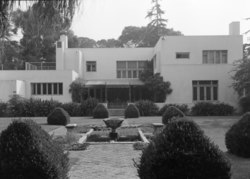Walter L. Dodge House
| Walter Luther Dodge House | |
|---|---|
 |
|
| General information | |
| Type | Reinforced concrete |
| Architectural style | Early Modern |
| Location | 950 N. Kings Rd., West Hollywood, California |
| Coordinates | 35°27′38.41″N 119°52′58.13″W / 35.4606694°N 119.8828139°WCoordinates: 35°27′38.41″N 119°52′58.13″W / 35.4606694°N 119.8828139°W |
| Construction started | 1914 |
| Completed | 1916 |
| Demolished | 1970 |
| Design and construction | |
| Architect | Irving Gill |
| Other information | |
| Number of rooms |
16 |
|
Walter Luther Dodge House
|
|
|
Formerly listed on the U.S. National Register of Historic Places
|
|
| NRHP Reference # | 68000058 |
| Significant dates | |
| Added to NRHP | 1968 |
| Removed from NRHP | 1970 |
16
The Walter L. Dodge House in West Hollywood, California, was an architecturally significant home, designed by Irving Gill in the Early Modern style. Though the Dodge House received significant recognition from architectural experts, it was targeted for redevelopment. A long preservation effort to shield it from the wrecking ball ultimately failed, ending with complete demolition in 1970. The Dodge House was replaced by apartments.
American architectural historian William Jordy and the American Institute of Architects ranked it among the 15 most architecturally significant American houses.
The 16-room house was designed by Gill in 1914 and built between 1914 and 1916 for Walter Luther Dodge, maker of "Tiz," a patented medicine for tired feet. The reinforced-concrete house blended Spanish Mission and Modern architectural styles. It also incorporated many technological innovations, including a kitchen-sink garbage disposal; an automatic car wash in the garage; plain, flush doors that swung on hidden hinges or slid into walls; a central vacuum cleaning system; sheet-metal doors; natural and unadorned (simply polished) wood surfaces indoors; and skylights and windows that provided for luminous sunlit interiors.
The Dodge House was considered one of Gill's finest works, "revealing a functional asymmetry whose ornament was derived solely from the studied geometry of the sharp openings in plain walls." In 1921, House Beautiful published a profile of the Dodge House by Eloise Roorbach and noted:
"This house, though unmistakably Californian, nevertheless exemplifies certain bold and novel ideas in design, construction and decoration that make it notable, even in this land where originality in architecture is to be expected.... It is without ornament save that furnished by vines, for he believes beauty should be organic and that no amount of ornament can redeem a badly designed structure. There is not even an overhanging roof to break the severity of the exterior, and as may be seen in the photograph, there is a distinction, a dignity about it that is classic. Mr Gill thinks there is nothing more arrestingly beautiful than a plain wall across which move cloud shadows or a silhouette of flower, and that no carving or frescoing could more perfectly finish a doorway or window than a vine or creeper."
Walter Dodge used the house as his retirement home until 1924, when he sold it to T. Morrison McKenna for $125,000.
...
Wikipedia
